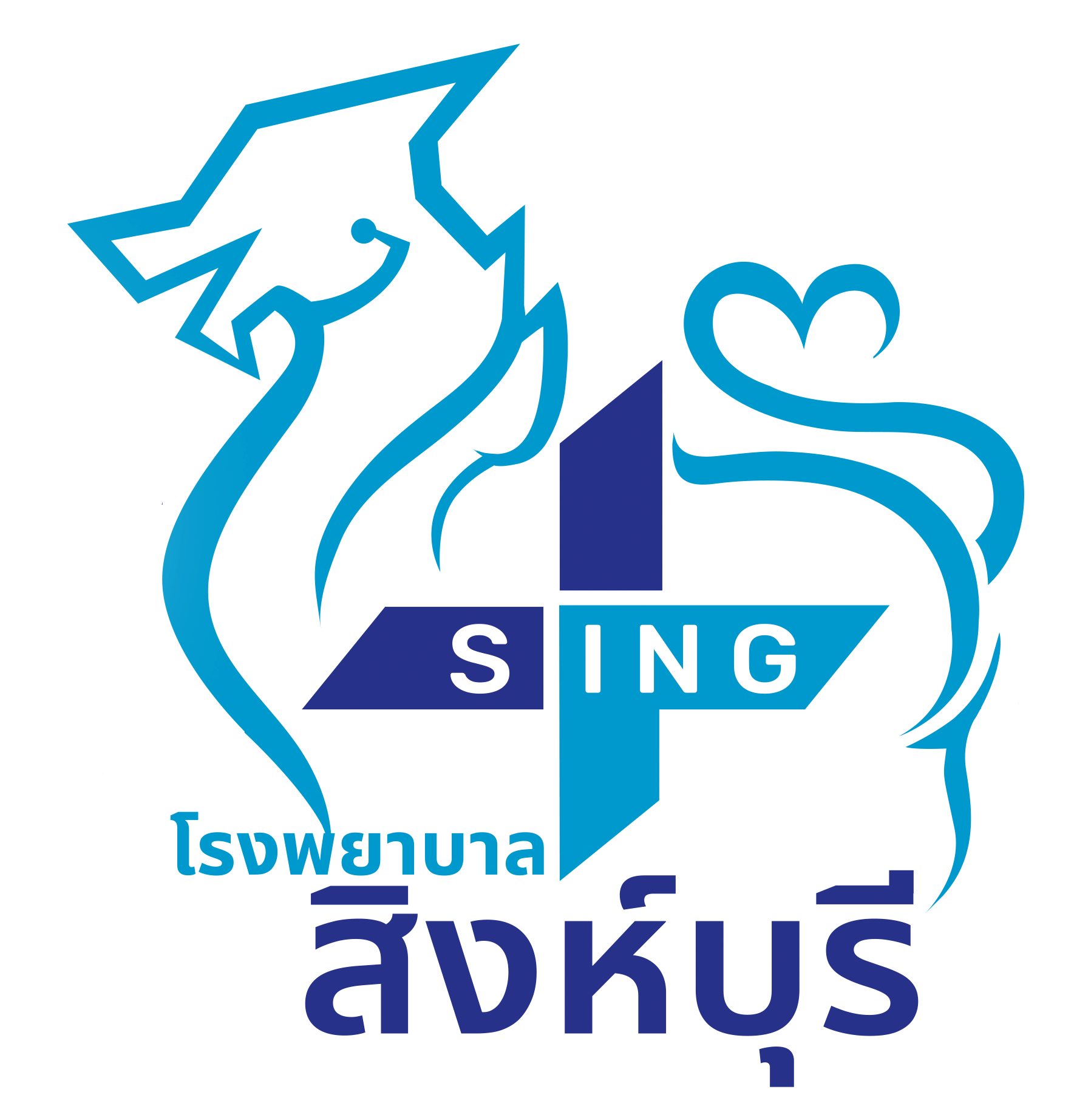ผลกระทบทางคลินิกของการเลือกใช้ยาปฏิชีวนะต่อผู้ป่วยเด็กโรคปอดอักเสบชนิดเฉียบพลัน ในโรงพยาบาลสิงห์บุรี
คำสำคัญ:
ยาปฏิชีวนะ, โรคปอดอักเสบชนิดเฉียบพลัน, ภาวะแทรกซ้อน, อัตราการใส่ท่อช่วยหายใจ, ค่าใช้จ่ายในการนอนโรงพยาบาลบทคัดย่อ
โรคปอดอักเสบชนิดเฉียบพลันเป็นโรคที่พบบ่อยเป็นอันดับ 1 และเป็นสาเหตุอันดับต้น ๆ ของการนอนโรงพยาบาลของผู้ป่วยเด็ก อีกทั้งมีการใช้ยาปฏิชีวนะในการรักษาอย่างกว้างขวางและหลากหลาย.จึงได้จัดทำการศึกษาขึ้นเพื่อเปรียบเทียบผลกระทบทางคลินิก ของการเลือกใช้ยาปฏิชีวนะระหว่างกลุ่มที่ใช้ยาปฏิชีวนะชนิดครอบคลุมเชื้อแคบ กับกลุ่มที่ใช้ยาปฏิชีวนะชนิดครอบคลุมเชื้อกว้างในเด็กที่เข้ารับการรักษาในโรงพยาบาลด้วยเรื่องปอดอักเสบชนิดเฉียบพลัน รูปแบบ Retrospective cohort study โดยเป็นการศึกษาย้อนหลังโดยรวบรวมข้อมูลจากเวชระเบียนผู้ป่วยเด็กที่ได้รับการวินิจฉัยโรคปอดอักเสบชนิดเฉียบพลันที่เข้ารับการรักษาในโรงพยาบาลตั้งแต่ พ.ศ.2561 ถึง พ.ศ.2564 ผู้ป่วยถูกแบ่งเป็นสองกลุ่ม ได้แก่ กลุ่มที่ใช้ยาปฏิชีวนะชนิดครอบคลุมเชื้อแคบ และกลุ่มที่ใช้ยาปฏิชีวนะชนิดครอบคลุมเชื้อกว้าง วิเคราะห์ข้อมูลโดยใช้สถิติเชิงพรรณนา วิเคราะห์ด้วยสถิติ t-test, multivariable risk(binary) regression analysis
ผู้ป่วยเด็กในการศึกษาจำนวนทั้งหมด 589 ราย แบ่งเป็น กลุ่มที่มีการใช้ยาปฏิชีวนะชนิดครอบคลุมเชื้อแคบ จำนวน 243 ราย (ร้อยละ 41.26) และกลุ่มที่มีการใช้ยาปฏิชีวนะชนิดครอบคลุมเชื้อกว้าง จำนวน 346 ราย (ร้อยละ 58.74 ) ลักษณะโดยทั่วไปมีความคล้ายคลึงกัน ในเรื่องผลกระทบทางคลินิกพบว่าการใช้ยาปฏิชีวนะชนิดครอบคลุมเชื้อแคบมีอัตราการใส่ท่อช่วยหายใจน้อยกว่ากลุ่มที่มีการใช้ยาปฏิชีวนะชนิดครอบคลุมเชื้อกว้างอย่างมีนัยสำคัญทางสถิติ (P = 0.026) ระยะเวลาในการใช้ออกซิเจนสั้นกว่าถึง 13 ชั่วโมง (P = 0.001) ระยะเวลาของไข้เฉลี่ยสั้นกว่าถึง 7 ชั่วโมง (P = 0.001) ระยะเวลาในการนอนโรงพยาบาลเฉลี่ยสั้นกว่า 1 วัน (P = 0.002) ตามลำดับ โดยไม่พบการนอนโรงพยาบาลซ้ำในระยะเวลา 7 วันเลยในทั้งสองกลุ่มที่มีการศึกษา และยังมีค่าใช้จ่ายในการรักษาเฉลี่ยต่ำกว่า 3438 บาท (P.=.0.001) โดยที่กลุ่มที่มีการใช้ยาปฏิชีวนะชนิดครอบคลุมเชื้อกว้าง มีโอกาสพบภาวะถ่ายเหลวเป็นภาวะแทรกซ้อนได้บ่อยกว่า
การใช้ยาปฏิชีวนะชนิดครอบคลุมเชื้อแคบมีประสิทธิภาพในการรักษาผู้ป่วยเด็กโรคปอดอักเสบชนิดเฉียบพลันไม่ด้อยกว่าการใช้ยาปฏิชีวนะชนิดครอบคลุมเชื้อกว้าง ในเรื่องอัตราการใส่ท่อช่วยหายใจ ระยะเวลาในการใช้ออกซิเจน ระยะเวลาของไข้ ค่าใช้จ่ายในการนอนโรงพยาบาล และยังช่วยลดภาวะแทรกซ้อนในเรื่องถ่ายเหลวจากการใช้ยาปฏิชีวนะลงได้
Downloads
เอกสารอ้างอิง
Hasan R, Rhodes J, Thamthitiwat S, et al. Incidence and etiology of acute lower respiratory tract infections in hospitalized children younger than 5 years in rural Thailand. Pediatr Infect Dis J. 2014;33(2):e45-52.
สญุมพร ชอบธรรม และ พรมนัส พันธุ์สุจริตไทย. ผลกระทบทางคลินิกของการใช้ออกซิเจนเสริมชนิดอัตราการไหลสูงต่อการรักษาผู้ป่วยเด็กติดเชื้อทางเดินหายใจส่วนล่างในโรงพยาบาลสระบุรี. วารสารกุมารเวชศาสตร์. 2019;58(2):88-94.
ธิดารัตน์ พันธุ์แก้ว. ปัจจัยที่มีผลกับการใช้ยาปฏิชีวนะในผู้ป่วยในเด็กอายุน้อยกว่า 5 ปี ที่เป็นโรคปอดอักเสบในชุมชน. วารสารกุมารเวชศาสตร์. 2019;58(2):103-12.
Leung AKC, Wong AHC and Hon KL. Community-Acquired Pneumonia in Children. Recent Pat. Inflamm Allergy Drug Discov. 2018;12(2):136-44.
ราชวิทยาลัยกุมารแพทย์แห่งประเทศไทย. แนวทางการดูแลรักษาโรคติดเชื้อเฉียบพลันระบบหายใจในเด็ก พ.ศ. 2562. กรุงเทพมหานคร: บริษัท บียอนด์เอ็นเทอร์ไพรซ์จำกัด; 2562. หน้า 116-44.
Nascimento-Carvalho CM. Community-Acquired Pneumonia among children: the latest evidence for an updated management.
J Pediatr (Rio J). 2020;96(S1):29-38.
Mathur S, Fuchs A, Bielicki J, Anker JVD and Sharland M. Antibiotics use for community-acquired pneumonia in neonates and children: WHO evidence review. Pediatr Int Child Health. 2018;38:S66-75.
Pratheepamornkul T, Ratanakorn W, Samransamruajkit R and Poovorawan Y. Causative Agents of Severe Community Acquired Viral Pneumonia Among Children in Eastern Thailand. Southeast Asian J Trop Med Public Health. 2015;46(4):650-6.
Driscoll AJ, Knoll MD, Hammitt LL, Baggett HC, Brooks WA, et al. The Effect of Antibiotic Exposure and Specimen Volume on the Detection of Bacterial Pathogens in Children With Pneumonia. Clin Infect Dis. 2017;64:S368-77.
Williams DJ, Edwards KM, Self WH, Zhu Y, Ampofo K, et al. Antibiotic Choice for Children Hospitalized With Pneumonia and Adherence to National Guidelines. Pediatrics. 2015;136:44-52.
Piralam B, Prosperi C, Thamthitiwat S, Bunthi C, Sawatwong P, et al. Pneumococcal colonization prevalence and density among Thai children with severe pneumonia and community controls. PLoS ONE. 2020;15(4):e0232151. http://doi.org/10.1371/journal.pone.0232151.
Marchello C, Dale AP, Thai TN, Han DS and Ebell MH. Prevalence of Atypical Pathogens in Patients With Cough and Comminity-Acquired Pneumonia: A Meta-Analysis. Ann Fam Med. 2016;14:552-66.
Lima EJF, Lima DEP, Serra GHC, Lima MAZA and Mello MJG. Prescription of antibiotics in community-acquired pneumonia in children: are we following the recommendations?. Ther Clin Risk Manag. 2016;12:983-8.
Nelson KA, Morrow C, Wingerter SL, Bachur RG and Neuman MI. Impact of Chest Radiography on Antibiotic Treatment for Children With Suspected Pneumonia. Pediatr Emerg Care. 2016;32(8):514-9.
Lipsett CS, Hall M, Ambroggio L, Hersh AL, Shah SS, et al. Antibiotic Choice and Clinical Outcomes in Ambulatory Children with Community-Acquired Pneumonia. J Pediatr. 2021;229(1):207-15.
Newman RE, Hedican EB, Herigon JC, Williams DD, Williams AR, et al. Impact of a Guideline on Management of Children Hospitalized With Community-Acquired Pneumonia. Pediatrics. 2020;129:e597-e604.
Lodha R, Kabra SK and Pandey RM. Antibiotics for community-acquired pneumonia in children. Cochrane DB Syst Rev. 2013;6:1-68.
Chang CC, Cheng AC and Chang AB. Over-the-counter(OTC) medications to reduce cough as an adjunct to antibiotics for acute pneumonia in children and adults. Cochrane DB Syst Rev. 2014;3:1-37.
Lassi ZS, Das JK, Haider SW, Salam RA, Qazi SA, et al. Systematic review on antibiotic therapy for pneumonia in children between 2 and 59 months of age. Arch Dis Child. 2014;0:1-7.
Nguyen PTK, Tran HT, Truong HTT, Nguyen VT, Graham SM, et al. Paediatric use of antibiotics in children with community acquired pneumonia: A survey from Da Nang, Vietnam. J Paediatr Child H. 2019;55(11):1329-34.
Florin TA, Byzkowski T, Gerber JS, Ruddy R and Kuppermann N. Diagnostic Testing and Antibiotic Use in Young Children With Community-Acquired Pneumonia in the United States, 2008-2015. J Pediatr Infect Dis Soc. 2020;9(2):248-52.
Lipshaw MJ, Eckerle M, Florin TA, Crotty EJ, Lipscomb J, et al. Antibiotic Use and Outcomes in Children in the Emergency Department With Suspected Pneumonia. Pediatrics. 2020;145(4):e20193138.
Graham K, Sinyangwe C, Nicholas S, King R, Mukuba S, et al. Rational use of antibiotics by community-health workers and caregivers for children with suspected pneumonia in Zambia: a cross-sectional mixed methods study. BMC Public Health. 2016;16:897.
Same RG, Amoah J, Hsu AJ, Hersh AL, Sklansky DJ, et al. The Association of Antibiotic Duration With Successful Treatment of Community-Acquired Pneumonia in Children. J Pediatr Infect Dis Soc. 2021:10(3)267-73.
Chang AB and Grimwood K. Antibiotics for Childhood Pneumonia-Do we Really Know How Long to Treat?. N Engl J Med. 2020;383(1):77-9.
Queen MA, Myers AL, Hall M, Shah SS, Williams DJ, et al. Comparative Effectiveness of Empiric Antibiotics for Community-Acquired Pneumonia. Pediatrics. 2014;133:1-7.
Hoang VT, Dao TL, Minodier P, Nguyen DC, Hoang NT, et al. Risk Factors for Severe Pneumonia According to WHO 2005 Criteria Definition Among Children <5 Years of Age in Thai Binh, Vietnam: A Case-Control Study. J Epidemiol Glob Health. 2019;9(4):274-80.
Erlichman I, Breuer O, Shoseyov D, Cohen-Cymberknoh M, Koplewitz B, et al. Complicated Community Acquired Pneumonia in Childhood: Different Types, Clinical Course, and Outcome. Pediatr Pulmonol. 2017:52(2):247-54.
Esposito S, Canto GD, Caramia MR, Fainardi V, Pisi G, et al. Complications in community acquired pneumonia: magnitude of problem, risk factors, and management in pediatric age. Expert Rev Anti infectTher. 2022:20(1):45-51.
Kwon J, Kong Y, Wade M, Williams DJ, Creech CB, et al. Gastrointestinal Microbiome Disruption and Antibiotic-Associated Diarrhea in Children Receiving Antibiotic Therapy for Community-Acquired Pneumonia. J Infect Dis. 2022;226(6):1109-19.
ดาวน์โหลด
เผยแพร่แล้ว
รูปแบบการอ้างอิง
ฉบับ
ประเภทบทความ
สัญญาอนุญาต
ลิขสิทธิ์ (c) 2024 โรงพยาบาลสิงห์บุรี

อนุญาตภายใต้เงื่อนไข Creative Commons Attribution-NonCommercial-NoDerivatives 4.0 International License.
บทความที่ได้รับการตีพิมพ์เป็นลิขสิทธิ์ของโรงพยาบาลสิงห์บุรี
ข้อความที่ปรากฏในบทความแต่ละเรื่องในวารสารวิชาการเล่มนี้เป็นความคิดเห็นส่วนตัวของผู้เขียนแต่ละท่านไม่เกี่ยวข้องกับโรงพยาบาลสิงห์บุรี และบุคคลากรท่านอื่นๆในโรงพยาบาลฯ แต่อย่างใด ความรับผิดชอบองค์ประกอบทั้งหมดของบทความแต่ละเรื่องเป็นของผู้เขียนแต่ละท่าน หากมีความผิดพลาดใดๆ ผู้เขียนแต่ละท่านจะรับผิดชอบบทความของตนเองแต่ผู้เดียว







